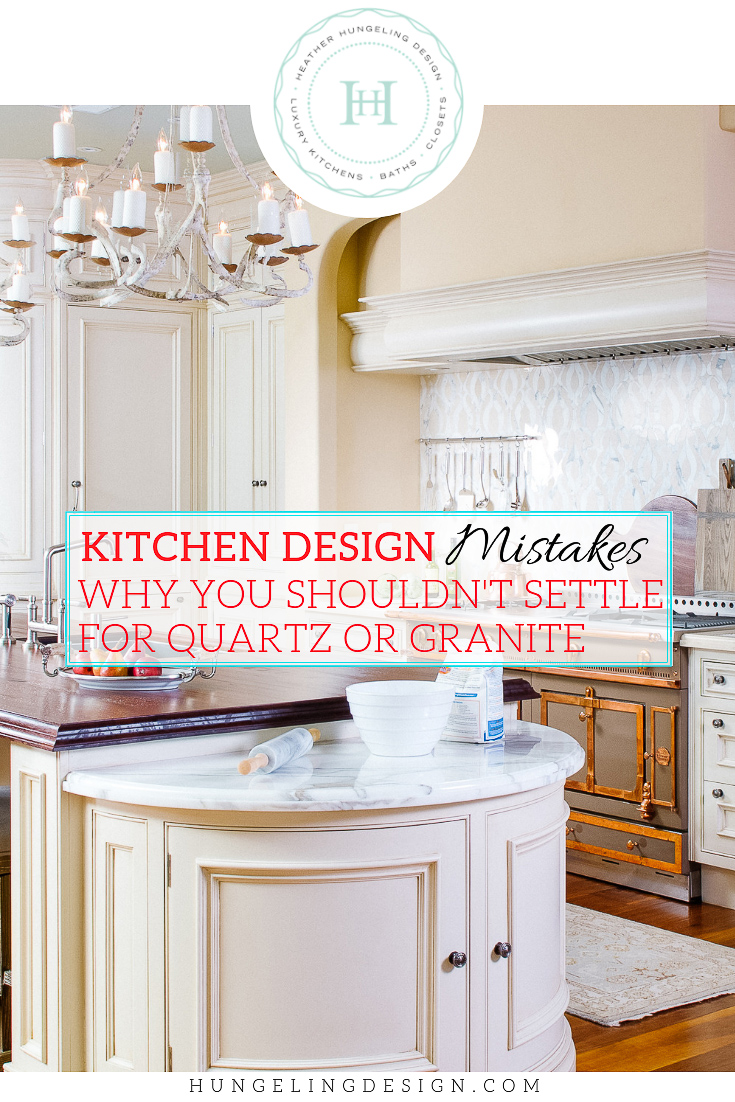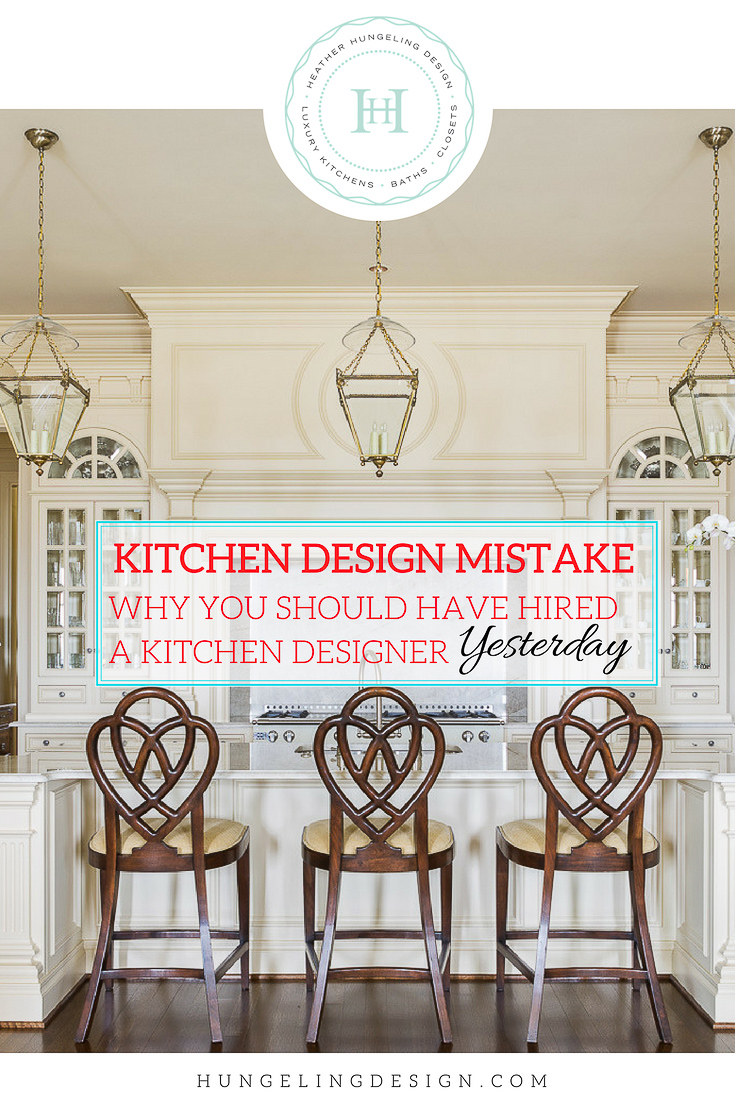What I Would Change About Your Kitchen Countertops
KITCHEN DESIGN MISTAKES: PART 3
I realize that by writing this, I’m going to offend a significant number of homeowners. Most of the kitchen remodels being done today feature either granite or quartz (an engineered material), and today I’m going to tell you why I don’t think these are good options. While both of these surfaces are popular and offer great convenience in durability, they are not the right choice if your heart is really lusting after something else. In my experience in the traditional market, these two material choices are seldom sought after because of their looks. Typically, a client will settle for one of these surfaces believing that they are the practical choice or a more durable alternative to what they actually love…marble.
But I’m here to tell you there are several other options (both natural and man-made) that you should consider first.
Since granite and quartz each offer different attributes and suffer from distinct inequities, let’s look at each one separately.
Source: Heather Hungeling Design | Willow Lane Project
WHY YOU SHOULDN’T SETTLE FOR GRANITE
Granite is like the hardworking draft horse with unsightly proportions, stodgy legs, and a dull coat. He’s sturdy and tough, but he’s never going to pull the carriage to the ball. Still, one can appreciate the durability of granite. It’s extremely hard, difficult to stain or scratch, and can tolerate very high heat. It doesn’t ask for much in return…just a little penetrating sealer once in a while to prevent stains.
The problem with granite is almost entirely aesthetic. When I’ve had clients choose granite in the past, it was never because they loved granite. They accepted it only because they wanted the durability they associate with this tough stone. They’ll go to the slab yard and try to find something they can bear to live with...“well, this one’s not so bad,”…etc.
Granted, some types of granite are subtle and leagues better than the speckled nature we mostly associate with this stone. However, unless you are looking to pair a very bold patterned counter with minimalist cabinetry (as often seen in contemporary kitchens), there are better options available to you now. Granite is harsh in appearance and detracts from any kind of delicate detailing or refinement that you will see in fine bench-made cabinetry.
If you are investing well in quality cabinetry for a traditional kitchen, I assure you that you will bring the caliber of your space down substantially if you pair it with granite.
WHY YOU SHOULDN’T SETTLE FOR QUARTZ
At this point, you may be wondering what I could possibly have against engineered quartz. It certainly looks a lot better than granite, but still offers considerable durability (very stain resistant, very scratch resistant and no need to maintain with a sealer). Every kitchen designer and interior designer on HGTV seems to be plugging it for their projects. In fact, quartz has recently surpassed granite as the most popular countertop material in America. With a lot of manufacturers stepping into this market, there is a wide variety of choices to suit almost every color scheme. Notably, there are also a lot of marble look-a-like patterns offered by these manufacturers, making them a trendy alternative to the real stone.
Well, let me tell you why I haven’t jumped on the quartz bandwagon…
Quartz slabs have a distinct sheen to them, which makes them easy to spot. Also, while the technology behind making them into a marble look-a-like has improved, I still find the slabs to be very lifeless. There’s no poetic beauty to them. Every piece is identical, and the more popular patterns can be easily spotted in kitchen renovation pictures.
Historically, anything that’s artificially made (and trendy) will inevitably become very “dated.”
The technology is always improving, but that can leave you with the feeling of having “last year’s model” pretty quickly.
Quartz is heat resistant to low temperatures but will scorch if exposed to high temperatures, such as a hot skillet or a pan directly from the oven.
Quartz is not UV resistant so the colors will fade slightly over time, depending on the amount of sun exposure. (They are not a good option for an outdoor area).
Engineered Alternatives to Quartz & Granite
In fairness, most of my criticisms of quartz can be applied to other engineered surfaces as well. That’s why I almost always prefer to use natural stone. However, I will concede that an engineered surface may be an appropriate choice for you if you’re going for a more transitional or contemporary kitchen - as they certainly contribute to a clean, modern look. Also, if you’re opting for that style of kitchen, you’re probably already expecting that you will need to update more frequently so the shorter style lifespan of your countertops may not be an issue for you.
Another group of people that may benefit more from an engineered material are those that don’t like to see any movement or color variation in their countertops. My mother-in-law falls into this category. While her taste is traditional, she prefers for the counters to be as visually “quiet” as possible.
If you find yourself in a particular situation where you’re more drawn to an engineered surface, I still believe there are two options for you that are superior to the ever-popular quartz:
PORCELAIN SLABS
Gaining traction in the market place are porcelain slabs, which are made from natural materials (considered environmentally friendly) compressed and fired under high heat. The result is an extremely tough and durable surface. They provide the most realistic engineered alternative to marble and they are offered in a vast array of patterns, solids, and colors as well.
Highly scratch resistant (exception: can be scratched by ceramic knives)
Very tolerant of high heat. You can set a boiling hot pot directly on it
Will not etch
Non-porous and very stain resistant
Highly impact resistant (although it is possible to chip an edge, it is very unlikely)
It will not fade over time due to UV exposure
Suitable for outdoor applications
Considered hygienic because they are non-porous and prevent the build-up of bacteria or mold
In my opinion, the most significant reason that this material is superior to quartz is that the printing (or pattern reproduction) is better. With quartz, the pattern penetrates throughout the thickness of the material, which may sound like a good thing, but it causes limitations with the quality of the pattern reproduction. With porcelain, the pattern is printed only on the surface, which allows for the printing technology to significantly surpass that of quartz. The flip side of this quality is that if your porcelain countertops were ever to get a chip, you would be able to see that the pattern was only on the surface. However, since it is extremely unlikely to chip, due to its high impact resistance, this is a low concern.
The downside is that you have only one option for your edge detail - a squared off, straight edge. However, when you combine the fact that it’s the better-looking product along with the knowledge that it’s heat resistant and UV resistant, I think porcelain wins hands down. For porcelain slabs, I’m particularly fond of the products offered by Inalco and Florim.
ULTRA COMPACT SURFACE
This is an industry term used to describe the product offerings from several companies, with Dekton and Neolith as the front-runners. If you’re looking for a bullet-proof countertop choice, then this material comes closer than anything else (natural or man-made). These countertops combine a lot of the same natural raw materials as used in the manufacture of porcelain and glass countertops. However, they have added in some of the natural materials used in engineering quartz countertops as well, which results in the most durable surface on the market.
Highly scratch resistant
Very tolerant of high heat. You can set a boiling hot pot directly on it.
Will not etch
Non-porous and very stain resistant
Highly impact resistant (although it is possible to chip an edge, it is very unlikely)
Will not fade over time due to UV exposure
Suitable for outdoor applications
Considered hygienic because they are non-porous and prevent the build-up of bacteria or mold
Similar to porcelain in that the pattern is printed on the surface resulting in a more realistic product. However, with their colored slabs, the pigment does extend throughout the thickness of the slab (just not the pattern).
Also similar to porcelain in that you are limited to a squared-off profile for the edge detail. All in all, ultra-compact surfaces are very similar to porcelain. However, the extreme compression and heat used to manufacture them provide the finished product with a slight durability advantage over porcelain…and certainly over quartz.
Natural Stone Alternatives to Quartz & Granite
If you’re the type of person who feels a spark of joy at the site of an exquisite piece of natural stone, then I think it’s a mistake to abandon your heart for the world of engineered perfection. No matter how great the printing process gets with marble, you will never gaze at your countertops and appreciate the miracle of creation that made them over millions of years. But I’m here to tell you that you don’t need to forsake the natural realm in order to have something practical too. Here are two options that you may not be familiar with:
Source: Heather Hungeling Design | Wentworth Place Project
QUARTZITE
Not to be mistaken with the term quartz (the engineered material). Quartzite, in contrast, is a natural stone with much of the beauty of marble, yet harder than granite. The most important quality is that it doesn’t etch! If you’ve read my other post about Using Marble Countertops in the Kitchen, then you already know that etching is the Achilles Heel of marble. Staining isn’t really much of an issue if it’s been properly sealed, but the sealer cannot protect marble from acidic things that will cause etch marks.
If you love the look of marble but are afraid of the etching, I strongly urge you to look at quartzite. My clients will fall in love with a quartzite as readily as with marble. I’m always surprised by how few people know about this. I’ve even found that some kitchen designers are unaware of the benefits of quartzite.
When I first began specifying quartzite on my projects (about ten years ago), there were only a few slabs available at my local stone yards. That’s changed quite a bit, at least in major cities. Still, the newfound popularity of this material can make finding a great slab a bit tricky. If you are not near a major metropolitan area, I encourage you to take a drive, as your choices will undoubtedly be better in a larger city.
Also, be aware that many stone yards inadvertently confuse quartzites with marbles and vice versa. You may need to do some research to make sure that the product you are looking at is, in fact, a quartzite.
Finally, a lot of quartzites tend to run more in the taupe color range, as opposed to white. But there are some really beautiful white quartzites if you care to partake in the hunt.
Calacatta Do Brasil Quartzite via Pietra Luxury in Stone
Taj Mahal Quartzite via Pietra Luxury in Stone
AZEROCARE MARBLE
Antolini, an Italian manufacturer of marble, quartzite, and onyx, has revolutionized the industry with a patented (and highly guarded) process that renders a marble or onyx slab highly stain resistant, and amazingly….highly etch resistant as well! You can leave red wine or lemon juice, etc., sitting on the marble overnight without any concerns about damaging your beautiful counters. This is a complete game changer for most folks. The treatment is done in Italy to the quarried slabs. It cannot be applied afterward to the finished countertop. So you need to look for a distributor in your area and ask specifically for “Azerocare” slabs.
It is important to note that the treatment is only possible for polished marble and onyx surfaces at this time. They are working on a similar process that can be applied to a honed finish, so let’s all keep our fingers crossed!
I’m only lightly touching on Azerocare in this post because I’ve decided to devote my next article entirely to this product. If you’re dying to find out more before then, I highly recommend you visit Antolini’s website for more information and a list of distributors in your area. Also, if you live anywhere near Atlanta, Pietra exclusively carries Antolini’s slabs and is worth the drive. The two images below are just a small sampling of what they have. The first image shows a bundle of particularly stunning slabs of Calacatta (similar to Calacatta Gold). I’m sure these won’t last long!
“Calacatta Top” AZEROCARE Marble via Pietra Luxury in Stone
“White Super” AZEROCARE Marble via Pietra Luxury in Stone
This concludes my 3 part series on Kitchen Design Mistakes. If you missed Part 1 (Layout Mistakes) or Part 2 (Cabinetry Design Mistakes), be sure to check those out as well. I hope this post has helped you come to terms with what you really want and to make the extra effort to seek it out.
Also, if you find the idea of stain and etch-proof marble intriguing, be sure to subscribe below to receive notification about my next post on Azerocare Marble. You’ll also get access to my Luxury Resource Library. Have a great week!









